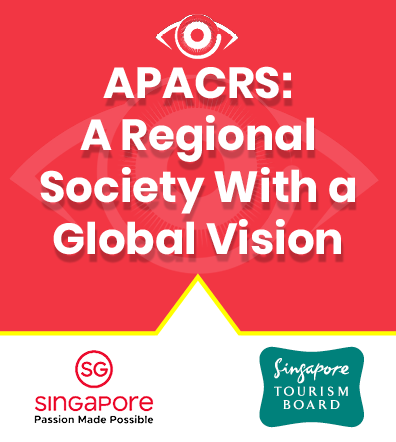Eyeworld Weekly Update |
Volume 20, Number 28 |
24 July 2015 |
- FDA approves iDesign
- Glaucoma medicine Vesneo NDA filed
- NICE gives nods to Eylea, Ozurdex for DME
- Gevokizumab for Behçet's disease uveitis fails to meet primary endpoint
- Top ophthalmology hospitals announced
- Oral AMD drug shows promise
- Argus II now in studies for dry AMD
FDA approves iDesign
The iDesign Advanced WaveScan Studio System has received U.S. regulatory clearance, developer Abbott Medical Optics (Abbott Park, Ill.) said in a press release.
The system captures more than 1,200 micro readings of the eye, as well as identifies the shape of the cornea, its curvature, how light passes through the eye and pupil diameter under different lighting conditions in a single 3-second scan.
In a clinical study of 334 eyes treated with the iDesign System, 99% of patients experienced little or no difficulty with the clarity of their vision and 97% of patients had little or no difficulty with their daily activities after surgery. In addition, patients saw significant improvements in their vision while driving at night and a reduction in glare, Abbott Medical Optics said.
Glaucoma medicine Vesneo NDA filed
Bausch + Lomb (Bridgewater, N.J.) and Nicox (Paris) have filed a New Drug Application (NDA) for Vesneo (latanoprostene bunod) 0.024% in the United States for the reduction of intraocular pressure (IOP) in patients with glaucoma or ocular hypertension, the companies announced.
Positive top-line results from two pivotal phase 3 studies served as the basis for the filing. Vesneo is a novel nitric oxide-donating prostaglandin F2-alpha analog that showed non-inferiority to timolol maleate 0.5% in the two studies, and showed a mean reduction in IOP of 7.5 to 9.1 mm Hg from baseline at various time points in the studies, ranging from 2 to 12 weeks.
NICE gives nods to Eylea, Ozurdex for DME
In two separate guidance alerts, the National Institute for Health and Care Excellence (London) has recommended both Eylea (aflibercept, Bayer HealthCare, Leverkusen, Germany) and Ozurdex (dexamethasone, Allergan, Dublin, Ireland) for the treatment of diabetic macular edema.
NICE has qualified coverage, noting Eylea would be subsidized if the central retina is at least 400 microns thick, and Ozurdex if the patient is pseudophakic and has already been treated with non-corticosteroids (or cannot have non-corticosteroid treatment).
Gevokizumab for Behçet's disease uveitis fails to meet primary endpoint
The phase 3 EYEGUARD-B study of gevokizumab in patients with Behçet's disease uveitis did not meet the primary endpoint of time to first acute ocular exacerbation, developer Xoma Corporation (Berkeley, Calif.) said in a press release. The drug did, however, meet several "clinically relevant" end points including preserved visual acuity, less severe ocular exacerbations, and a reduced incidence of reported macular edema.
Top ophthalmology hospitals announced
U.S. News & World Report has released the 2015-2016 best hospitals list, and the top 5 ophthalmic institutions are: Bascom Palmer Eye Institute (Miami), Wills Eye (Philadelphia), Wilmer Eye Institute (Baltimore), Massachusetts Eye & Ear Infirmary (Boston), and Stein and Doheny Eye Institutes (Los Angeles).
Oral AMD drug shows promise
A phase 1 safety study of orally administered X-82 for wet age-related macular degeneration (AMD) found the drug was able to maintain or improve vision in all subjects who received the drug for the 6-month study duration, and most subjects did not require any rescue injections during that time, developer Tyrogenex (Needham, Mass.) said in a news release. There were no dose-limiting toxicities encountered during the study. X-82 is a dual inhibitor of vascular endothelial growth factor (VEGF) and platelet-derived growth factor (PDGF) and to date is the only oral medication under evaluation for AMD. Tyrogenex plans to initiate the phase 2 APEX study on X-82.
APEX is a randomized, double-masked, placebo-controlled, dose-finding study being conducted throughout the U.S. at 20 sites and 5 sites in the U.K. The study is designed to evaluate the safety and efficacy of X-82 in the prevention of vision loss due to wet AMD. APEX is expected to enroll 132 subjects. The primary endpoint of the APEX study is the mean change in visual acuity score from day 1 to 52 weeks after randomization. Another key endpoint is the reduction of the number of injections needed for the duration of the study
Argus II now in studies for dry AMD
The first patient with dry age-related macular degeneration (AMD) has been implanted with the Argus II Retinal Prosthesis System as part of a feasibility study, developer Second Sight (Sylmar, Calif.) said in a press release.
Eligibility for this study includes patients 25 to 85 years of age with advanced dry AMD, some residual light perception, and a previous history of useful form vision. Study subjects will be followed for 3 years to evaluate safety and utility of the Argus II system on visual function. Pending positive study results, Second Sight will conduct a larger study to support market approvals.
RESEARCH BRIEFS
- The bitoric IOL AT TORBI 709M (Carl Zeiss Meditec, Jena, Germany) is able to provide a predictable correction of corneal astigmatism with low postoperative levels of ocular higher order aberrations, according to Florian T.A. Kretz, MD, and colleagues. They retrospectively evaluated 41 eyes of 24 patients with preexisting corneal astigmatism of 0.75 D or greater undergoing cataract surgery. A total of 76% and 97% of eyes had a postoperative spherical equivalent within ±0.50 and ±1.00 D of emmetropia, respectively. Likewise, a total of 86% and 95% of eyes had a postoperative absolute value of refractive cylinder of 0.50 or less and 1.00 or less diopters, respectively. Mean postoperative corrected distance visual acuity was 0.00 logMAR (20/20 Snellen). Mean values of postoperative monocular and binocular uncorrected distance visual acuity were 0.10 and 0.00 logMAR (20/25 and 20/20 Snellen), respectively. The study is published in the Journal of Refractive Surgery.
- Switching therapy from benzalkonium chloride-preserved latanoprost to travoprost preserved with SofZia (Alcon, Fort Worth, Texas) ameliorated chronic superficial punctate keratitis (SPK), according to Makoto Aihara, MD, and the NEXTraKT Study Group. This prospective, randomized, controlled, multicenter, open-label, comparative 3-month follow-up study evaluated 56 patients with open angle glaucoma or ocular hypertension who received latanoprost monotherapy for at least 3 months and had SPK in both eyes. For each patient, 1 eye was randomly selected and switched to travoprost with SofZia (T-group); the contralateral control eye was treated with latanoprost (X-group). The frequency of SPK significantly decreased from baseline in the T-group and the X-group at 1 and 3 months (T-group, P<0.001; X-group, P<0.05). In the T-group, SPK scores were significantly improved in 4 corneal regions, excluding the superior region, at 1 and 3 months (all P<0.05), whereas in the X-group, SPK scores were significantly improved only in the temporal region at 1 month and in the inferior region at 3 months (P<0.05 for both). The total SPK score at 1 and 3 months in the T-group was significantly lower compared with the score in the X-group (P=0.0023 and 0.0102, respectively). The study is published in the Journal of Glaucoma.
- A 2014 online survey of the American Society of Cataract & Refractive Surgery members indicated increasing use of intracameral antibiotic injection prophylaxis compared with a comparable survey from 2007, according to David F. Chang, MD, and the ASCRS Cataract Clinical Committee. Forty-seven percent of respondents already used or planned to adopt this measure. One half of all surgeons not using intracameral prophylaxis expressed concern about the risks of non-commercially prepared antibiotic preparations. Overall, the large majority (75%) said they believe it is important to have a commercially available antibiotic approved for intracameral injection. Assuming reasonable cost, the survey indicates that commercial availability of Aprokam (cefuroxime) would increase the overall percentage of surgeons using intracameral antibiotic injection prophylaxis to nearly 84%. Although the majority used topical perioperative antibiotic prophylaxis, and gatifloxacin and moxifloxacin were still the most popular agents, there was a trend toward declining use of fourth-generation fluoroquinolones (60%, down from 81% in 2007) and greater use of topical ofloxacin and ciprofloxacin (21%, up from 9% in 2007). The information is published in the Journal of Cataract & Refractive Surgery.
 Licensed Publications |
Licensed through ASCRS American Society of Cataract and Refractive Surgery, 4000 Legato Road, Suite 700, Fairfax, VA 22033-4003, USA.
All rights reserved. The ideas and opinions expressed in EyeWorld Asia-Pacific Weekly News do not necessarily reflect those of the ASCRS�ASOA or APACRS. Mention of products or services does not constitute an endorsement by the ASCRS�ASOA or APACRS. Copyright 2008, EyeWorld News Service, a division of ASCRS Media. |



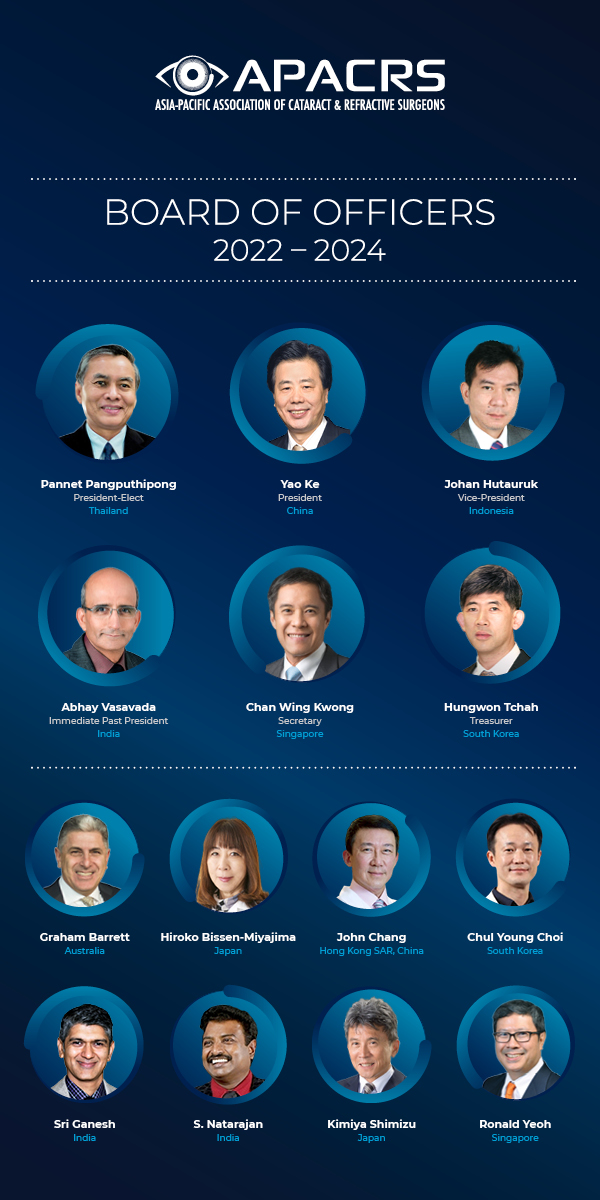
 EyeSustain Update
EyeSustain Update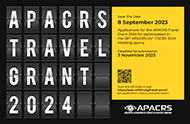 2024 APACRS TRAVEL GRANT
2024 APACRS TRAVEL GRANT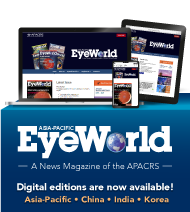 Digital EyeWorld
Digital EyeWorld VOL. 39 (2023), ISSUE 3
VOL. 39 (2023), ISSUE 3  Membership Information
Membership Information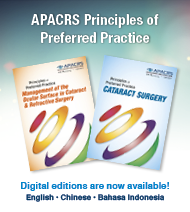 APACRS Principles of Preferred Practice
APACRS Principles of Preferred Practice